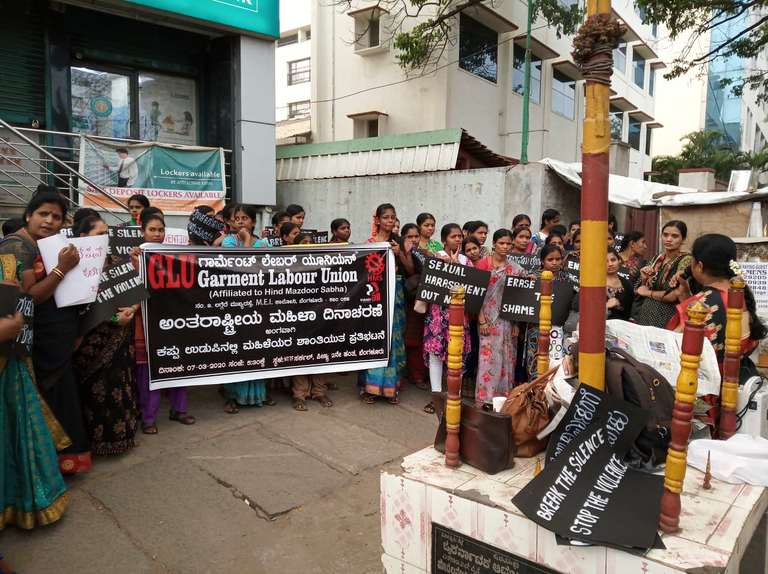The problem
An estimated 60 million workers power the global garment industry, generating its billions of profit. 80% of these workers are female, and this is not a coincidence, but part of a wider integrated business practice creating obstacles for workers to realise their basic rights at work. The industry is notorious for its less-than-decent working conditions, with low wages, forced overtime and unsafe working conditions. In the factories where major brands buy the clothes they sell, women are often deprived of maternity leave, child care and safe travel to work. These structural violations are compounded by the prevalence of gender based violence.
Brands choose to source from countries where labour laws are weak, and workers have little opportunities to organise in order to make sure they can enjoy their basic rights. Women bear the burden of domestic work and child care next to their factory job, and often have little time to organise themselves and fights for their rights. Their gendered roles in society make that they have a lot to loose when they voice their dissent. Their lack of ability to organise sometimes reinforces the stereotype of women as docile beings, due to being female. However, the women workers in our network show strong factory workers, going against many of the stereotypes that exist around ideas about their ‘natural’ roles in society. The risks they take are real and the stakes high.

Garment workers in Bangladesh celebrated Women's day 2020 with a protest demanding the Bangladesh govegnment ratify C190: The Violence and Harassment Convention, recognized by the ILO in 2019.


"Break the silence - Stop the violence" - Garment Labour Union's Women's Day protest, India, 2020
What we do
The CCC network is built to offer direct solidarity to the workers in the factories. We strive to have a network consisting of organised women workers, and the people on the factory floor are leading in decision making around our strategies. One way we do this is by our core work of Urgent Appeals; this means we deliver direct solidarity to the women making our clothes who stand up against the violations of their rights. Within our network, this mutual capacity development leads to a strong network with a clear voice for women workers.
In June 2019, after years of campaigning by some of our partners, the International Labour Organisation passed the historic treaty to reduce workplace harassment. This is the first international standard specifically aimed at addressing these issues in the workplace and our network will push governments and brands to make sure it gets implemented.
Freedom of association, the right to bargain, and the rights to organise are pivotal stepping stones for women to realise their rights. Clean Clothes Campaign lobbies and advocates towards brands, governments and other stakeholders to ensure these basic human rights, and make sure they don’t get forgotten when we talk about a sustainable garment industry.
Background
The vast majority of garment workers – approximately 80% – are women. This is not by chance, but the result of discriminatory practices from start to finish. Women are desirable in the garment industry because employers take advantage of cultural stereotypes – to which women are often obliged to adhere – that portrays women as passive and flexible. Productive, reproductive and domestic responsibilities such as cleaning, cooking and childcare constrain women’s ability to seek other types of employments. they just do not have the time or opportunity to improve their working conditions, or even speak out about the abuses they face on a daily basis, making them the ideal employees in management’s eyes.
Gender discrimination runs deep throughout all of the countries in which garments are currently produced. Women are frequently subjected to verbal and physical abuse and sexual harassment. They also work under the fear of perhaps being assaulted or raped on their way home from work late at night.
Latest publications on women in the garment industry
-
March 6, 2023
Ensuring a gender-responsive Corporate Sustainability Due Diligence legislation
On the eve of Women's Day 2023, over 140 organisations sent an open letter to European policy makers this morning calling them to ensure a gender responsive Corporate Sustainability Due Diligence legislation.
-
-
February 6, 2021
CCC network statement in response to Natchi Apparels case
Gender-based violence and harassment, including sexual harassment in the world of work, are among the most pervasive human rights violations. The recent report of the rape and murder of a 20-year-old Dalit garment worker at Natchi Apparels by her male supervisor, in Tamil Nadu exemplifies this fact.
-
November 16, 2020
Wages and Gender-based Violence
Exploring the connections between economic exploitation and violence against women workers
-
December 23, 2019
The global garment and footwear industry relies heavily on the work of women, who represent up to 80% of its global workforce. The current living wage debate presents both opportunities and risks for the millions of women workers in this industry. This paper argues that it is imperative to adopt a gender-sensitive approach in the living wage discourse, and to look at the implications that such an approach has on the methodology of calculating a living wage and on the measures to implement it.
-
August 27, 2019
CCC is committed to challenging the gender inequality and sex discrimination faced by garment workers, the vast majority of whom are women.
-
October 4, 2018
Fabricado por Mujeres (Made by Women, Spanish)
Spanish version of the Made by Women report from 2005. This 128-page publication published by the CCC International Secretariat includes feature articles on important themes relating to gender and labour rights and 17 profiles of women involved in different ways in the movement for garment workers' rights.
-
October 4, 2018
Made by Women (Fabrique par des femmes)
French translation of the Made by Women brochure from 2005.
1 - 8 of 17 Results








